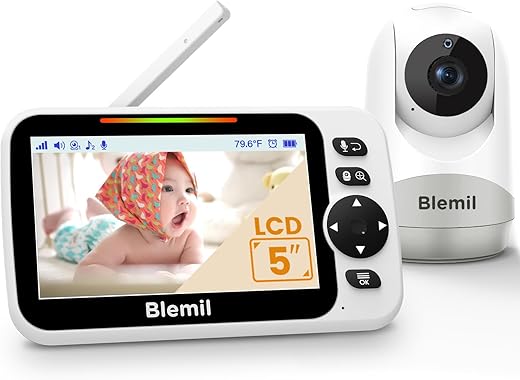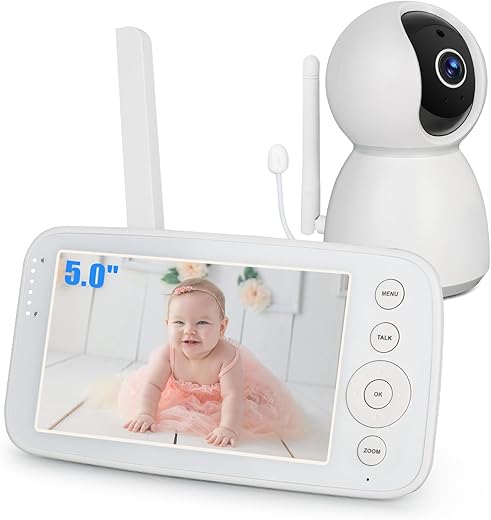Baby monitors are electronic devices that allow parents to keep an eye and ear on their babies without being in the same room. They are a popular choice for parents who want to ensure their babies are safe and secure while they sleep or play. Baby monitors come in different types and with various features to suit different parenting needs.

The most common types of baby monitors are audio, video, and movement monitors. Audio monitors allow parents to hear their baby’s sounds, while video monitors provide both audio and visual monitoring. Movement monitors detect the baby’s movements and sound an alarm if no movement is detected for a specific period. Some baby monitors come with all three features, while others have a combination of two or one. When choosing a baby monitor, parents need to consider their lifestyle, budget, and baby’s needs.
Key Takeaways
- Baby monitors are electronic devices that allow parents to keep an eye and ear on their babies without being in the same room.
- There are different types of baby monitors, including audio, video, and movement monitors, each with its own features.
- When choosing a baby monitor, parents need to consider their lifestyle, budget, and baby’s needs.
Types of Baby Monitors

When it comes to keeping an eye on your little one, baby monitors come in handy. There are various types of baby monitors available in the market today. Here are the three main types of baby monitors:
Audio Monitors
Audio monitors are the most basic type of baby monitors. They allow parents to hear their baby’s cries and sounds from another room. They consist of a transmitter, which is placed in the baby’s room, and a receiver, which is carried by the parent. Audio monitors are affordable and easy to use. They are ideal for parents who want to keep things simple.
Video Monitors
Video monitors, also known as baby cams, allow parents to see and hear their baby. They consist of a camera, which is placed in the baby’s room, and a monitor, which displays the video feed. Video monitors come with a range of features, including night vision, two-way communication, and pan and tilt. They are ideal for parents who want to keep a close eye on their baby’s movements.
Motion Monitors
Motion monitors, also known as breathing monitors, are designed to detect the movement of a baby’s chest. They sound an alarm if the baby stops breathing. Motion monitors consist of a sensor pad, which is placed under the baby’s mattress, and a monitor, which sounds the alarm. They are ideal for parents who are concerned about Sudden Infant Death Syndrome (SIDS) or have premature babies.
In conclusion, each type of baby monitor has its unique features and benefits. Parents should choose a baby monitor that suits their needs and budget.
Features to Consider

When it comes to choosing a baby monitor, there are several features to consider to ensure that it meets the needs of both the baby and the parents. Here are some of the most important features to consider:
Connectivity Options
One of the most important features to consider when choosing a baby monitor is the connectivity options. There are three main types of baby monitors: audio, video, and smart. Audio monitors are the most basic and transmit sound only, while video monitors transmit both sound and video. Smart monitors use Wi-Fi or Bluetooth to connect to a smartphone or tablet, allowing parents to access the feed from anywhere.
Battery Life
Another important consideration is the battery life of the baby monitor. Parents should look for a monitor with a long battery life to ensure that it lasts throughout the night. Some monitors come with rechargeable batteries, while others require disposable batteries.
Range and Signal Strength
The range and signal strength of the baby monitor is also an important consideration. Parents should choose a monitor with a strong signal that can transmit sound and video over a long distance. This is especially important for larger homes or for parents who want to monitor their baby from outside.
Safety and Privacy
Safety and privacy are also important considerations when choosing a baby monitor. Parents should choose a monitor that uses a secure connection to ensure that the feed is not intercepted by others. They should also choose a monitor that does not emit harmful radiation and that complies with safety standards.
Additional Functions
Finally, parents should consider any additional functions that the baby monitor may have. Some monitors come with features such as temperature sensors, sound-activated lights, and lullaby players. These additional functions can help to soothe the baby and provide additional peace of mind for parents.
In summary, when selecting a baby monitor, parents should consider the connectivity options, battery life, range and signal strength, safety and privacy, and any additional functions that the monitor may have. By carefully considering these features, parents can choose a monitor that meets their needs and provides peace of mind.
Frequently Asked Questions

Which baby monitor offers the best features for new parents?
The best baby monitor for new parents depends on their individual needs and preferences. Some parents may prefer a monitor with video capabilities, while others may prioritize sound quality or portability. The Nanit Pro and Infant Optics DXR-8 Pro are two highly-rated baby monitors that offer a range of helpful features. However, it’s important to do your research and read reviews to determine which monitor is best for you.
At what stage in a child’s development is a baby monitor no longer necessary?
There is no set age when a baby monitor is no longer necessary, as every child develops at their own pace. However, most parents find that they no longer need a baby monitor once their child can sleep through the night without waking up. This typically occurs around 6-12 months of age but can vary.
Is a Wi-Fi connection required for all types of baby monitors?
No, not all baby monitors require a Wi-Fi connection. Some monitors use radio frequencies to transmit sound and video, while others rely on Bluetooth technology. It’s important to check the specifications of each monitor to determine if a Wi-Fi connection is required.
How do baby monitors enhance the safety and monitoring of an infant?
Baby monitors allow parents to keep an eye and ear on their infant while they sleep or play in another room. This can provide peace of mind and help parents respond quickly if their child needs attention. Some monitors also offer features such as temperature sensors and movement tracking to further enhance safety and monitoring.
Can baby monitors with cameras and apps provide additional security?
Baby monitors with cameras and apps can provide additional security by allowing parents to view a live feed of their child’s room from their smartphone or tablet. Some monitors also offer features such as two-way audio and motion detection alerts, which can further enhance security.
Where can one find a reliable baby monitor in the UK?
Many retailers in the UK sell baby monitors, including Amazon, John Lewis, and Mothercare. It’s important to read reviews and compare features before purchasing to ensure that you find a reliable and high-quality monitor.












